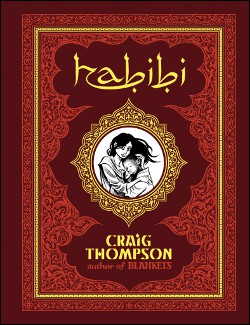 I’ll just go ahead and say it: I think Craig Thompson’s Habibi is one of the best — if not the best — examples of graphic novels as a medium.
I’ll just go ahead and say it: I think Craig Thompson’s Habibi is one of the best — if not the best — examples of graphic novels as a medium.
It blurs the lines of time and place, it uses traditional comic book panels and many design elements to carry the story, and it ends in a way that is everything the book is about.
Graphic Novels vs. Collections
When I say graphic novel, I mean graphic novel. The only comic books I have as bulky as Thompson’s 665-page Habibi are the Daredevil Omnibuses, published by Marvel. Some people call those graphic novels, but they aren’t — they are collections.
The comic book geek in me just has to clarify that.
Habibi was created to be read as one large work — not a collection of shorter releases.
So What’s the Deal?
Habibi is the story of two slaves in the Middle East: Dodola and Zam. Despite some harsh violence and tough times for the two that some people have found unsettling, there’s still a lot of magic in the book: the ways the two characters move through time — in and out of each others lives; the locations in the book, sometimes seeming like a fantasy world based on Middle Eastern design and lore — other times harkening to the construction of modern cities like Dubai and Abu Dhabi; the way Thompson slings ink and designs panels and pages.
It’s an awe-inspiring book to hold in one’s hands, and while there are times the scenes and story seem like a bit more of the same violence and trials, good writers often put their characters through hell. I won’t spoil the ending, but I was happy for the characters, and loved the last two-page spread ending the story.
Brought a tear to me eye and a smile to my face.
Is It Really the Best Example of the Medium?
I said Habibi is one of the best — if not the best — examples of a graphic novel. I say this for a variety of reasons.
While there were some sections of dialogue that seemed forced, and even some scenes that seemed just a bit much, that happens (even in some of my favorite novels). As a whole, Habibi combines story, writing, art, and design in ways few graphic novels do.
It’s an ambitious book, and Thompson pulls it off.
There are graphic novels I’ve read that I liked more than Habibi, but none that are the shining example of the medium that Habibi is.

Have you also read Blankets by Craig Thompson? That was my first graphic novel, and I fell in love with the story immediately. It was one of my favorite books that I read in 2011.
I was considering adding Habibi to my TBR list, but after your review, it’s a MUST read in 2012. Just requested it from my library. Thanks, Chris! 🙂
M.E.: I still need to read Blankets. I’ve always meant to check it out — I’ve liked the excerpts I’ve seen — but have yet to read it. I definitely plan to.
Habibi was great. There are parts that seem to repeat, but it all comes together so nicely. Hope you like it, too!